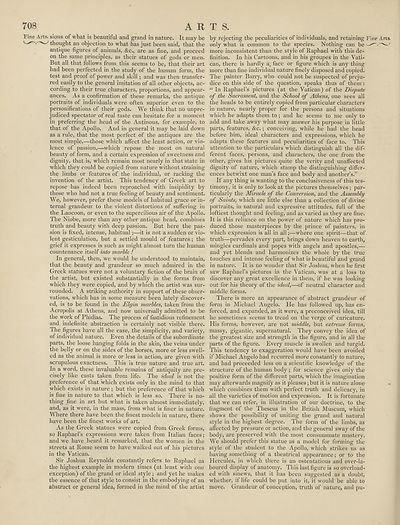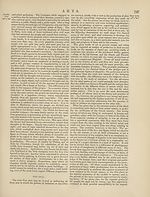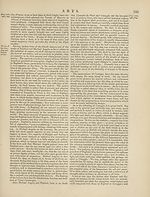Encyclopaedia Britannica > Volume 3, Anatomy-Astronomy
(716) Page 708
Download files
Complete book:
Individual page:
Thumbnail gallery: Grid view | List view

708 A R
Fine Arts, sions of what is beautiful and grand in nature. It may be
thought an objection to what has just been said, that the
antique figures of animals, &c., are as fine, and proceed
on the same principles, as their statues of gods or men.
But all that follows from this seems to be, that their art
had been perfected in the study of the human form, the
test and proof of power and skill; and was then transfer¬
red easily to the general imitation of all other objects, ac¬
cording to their true characters, proportions, and appear¬
ances. As a confirmation of these remarks, the antique
portraits of individuals were often superior even to the
personifications of their gods. We think that no unpre¬
judiced spectator of real taste can hesitate for a moment
in preferring the head of the Antinous, for example, to
that of the Apollo. And in general it may be laid down
as a rule, that the most perfect of the antiques are the
most simple,—those which affect the least action, or vio¬
lence of passion,—which repose the most on natural
beauty of form, and a certain expression of sweetness and
dignity, that is, which remain most nearly in that state in
which they could be copied from nature without straining
the limbs or features of the individual, or racking the
invention of the artist. This tendency of Greek art to
repose has indeed been reproached with insipidity by
those who had not a true feeling of beauty and sentiment.
We, however, prefer these models of habitual grace or in¬
ternal grandeur to the violent distortions of suffering in
the Laocoon, or even to the supercilious air of the Apollo.
The Niobe, more than any other antique head, combines
truth and beauty with deep passion. But here the pas¬
sion is fixed, intense, habitual;—it is not a sudden or vio¬
lent gesticulation, but a settled mould of features; the
grief it expresses is such as might almost turn the human
countenance itself into marble !
In general, then, we would be understood to maintain,
that the beauty and grandeur so much admired in the
Greek statues wrere not a voluntary fiction of the brain of
the artist, but existed substantially in the forms from
which they were copied, and by which the artist was sur¬
rounded. A striking authority in support of these obser¬
vations, which has in some measure been lately discover¬
ed, is to be found in the Elgin marbles, taken from the
Acropolis at Athens, and now universally admitted to be
the work of Phidias. The process of fastidious refinement
and indefinite abstraction is certainly not visible there.
The figures have all the ease, the simplicity, and variety,
of individual nature. Even the details of the subordinate
parts, the loose hanging folds in the skin, the veins under
the belly or on the sides of the horses, more or less swell¬
ed as the animal is more or less in action, are given with
scrupulous exactness. This is true nature and true art.
In a word, these invaluable remains of antiquity are pre¬
cisely like casts taken from life. The ideal is not the
preference of that which exists only in the mind to that
which exists in nature ; but the preference of that which
is fine in nature to that which is less so. There is no¬
thing fine in art but what is taken almost immediately,
and, as it were, in the mass, from what is finer in nature.
Where there have been the finest models in nature, there
have been the finest works of art.
As the Greek statues were copied from Greek forms,
so Raphael’s expressions were taken from Italian faces;
and we have heard it remarked, that the women in the
streets at Rome seem to have walked out of his pictures
in the Vatican.
Sir Joshua Reynolds constantly refers to Raphael as
the highest example in modern times (at least with one
exception) of the grand or ideal style ; and yet he makes
the essence of that style to consist in the embodying of an
abstract or general idea, formed in the mind of the artist
T S.
by rejecting the peculiarities of individuals, and retaining Fine Arts,
only what is common to the species. Nothing can be
more inconsistent than the style of Raphael with this de¬
finition. In his Cartoons, and in his groupes in the Vati¬
can, there is hardly a. face or figure which is any thing
more than fine individual nature finely disposed and copied.
The painter Barry, who could not be suspected of preju¬
dice on this side of the question, speaks thus of them :
“ In Raphael’s pictures (at the Vatican) of the Dispute
of the Sacrament, and the School of Athens, one sees all
the heads to be entirely copied from particular characters
in nature, nearly proper for the persons and situations
which he adapts them to; and he seems to me only to
add and take away what may answer his purpose in little
parts, features, &c.; conceiving, while he had the head
before him, ideal characters and expressions, which he
adapts these features and peculiarities of face to. This
attention to the particulars which distinguish all the dif¬
ferent faces, persons, and characters, the one from the
other, gives his pictures quite the verity and unaffected
dignity of nature, which stamp the distinguishing differ¬
ences betwixt one man’s face and body and another’s.”
If any thing is wanting to the conclusiveness of this tes¬
timony, it is only to look at the pictures themselves; par¬
ticularly the Miracle of the Conversion, and the Assembly
of Saints, which are little else than a collection of divine
portraits, in natural and expressive attitudes, full of the
loftiest thought and feeling, and as varied as they are fine.
It is this reliance on the power of nature which has pro¬
duced those masterpieces by the prince of painters, in
which expression is all in all;—where one spirit—that of
truth—pervades every part, brings down heaven to earth,
mingles cardinals and popes with angels and apostles,—
and yet blends and harmonizes the whole by the true
touches and intense feeling of what is beautiful and grand
in nature. It is no wonder that Sir Joshua, when he first
saw Raphael’s pictures in the Vatican, was at a loss to
discover any great excellence in them, if he was looking
out for his theory of the ideal,—of neutral character and
middle forms.
There is more an appearance of abstract grandeur of
form in Michael Angelo. He has followed up, has en¬
forced, and expanded, as it were, a preconceived idea, till
he sometimes seems to tread on the verge of caricature.
His forms, however, are not middle, but extreme forms,
massy, gigantic, supernatural. They convey the idea of
the greatest size and strength in the figure, and in all the
parts of the figure. Every muscle is swollen and turgid.
This tendency to exaggeration would have been avoided
if Michael Angelo had recurred more constantly to nature,
and had proceeded less on a scientific knowledge of the
structure of the human body; for science gives only the
positive form of the different parts, which the imagination
may afterwards magnify as it pleases; but it is nature alone
which combines them with perfect truth and delicacy, in
all the varieties of motion and expression. It is fortunate
that we can refer, in illustration of our doctrine, to the
fragment of the Theseus in the British Museum, which
shows the possibility of uniting the grand and natural
style in the highest degree. The form of the limbs, as
affected by pressure or action, and the general sway of the
body, are preserved with the most consummate mastery.
We should prefer this statue as a model for forming the
style of the student to the Apollo, which strikes us as
having something of a theatrical appearance; or to the
Hercules, in which there is an ostentatious and over-la¬
boured display of anatomy. This last figure is so overload¬
ed with sinews, that it has been suggested as a doubt,
whether, if life could be put into it, it w ould be able to
move. Grandeur of conception, truth of nature, and pu-
Fine Arts, sions of what is beautiful and grand in nature. It may be
thought an objection to what has just been said, that the
antique figures of animals, &c., are as fine, and proceed
on the same principles, as their statues of gods or men.
But all that follows from this seems to be, that their art
had been perfected in the study of the human form, the
test and proof of power and skill; and was then transfer¬
red easily to the general imitation of all other objects, ac¬
cording to their true characters, proportions, and appear¬
ances. As a confirmation of these remarks, the antique
portraits of individuals were often superior even to the
personifications of their gods. We think that no unpre¬
judiced spectator of real taste can hesitate for a moment
in preferring the head of the Antinous, for example, to
that of the Apollo. And in general it may be laid down
as a rule, that the most perfect of the antiques are the
most simple,—those which affect the least action, or vio¬
lence of passion,—which repose the most on natural
beauty of form, and a certain expression of sweetness and
dignity, that is, which remain most nearly in that state in
which they could be copied from nature without straining
the limbs or features of the individual, or racking the
invention of the artist. This tendency of Greek art to
repose has indeed been reproached with insipidity by
those who had not a true feeling of beauty and sentiment.
We, however, prefer these models of habitual grace or in¬
ternal grandeur to the violent distortions of suffering in
the Laocoon, or even to the supercilious air of the Apollo.
The Niobe, more than any other antique head, combines
truth and beauty with deep passion. But here the pas¬
sion is fixed, intense, habitual;—it is not a sudden or vio¬
lent gesticulation, but a settled mould of features; the
grief it expresses is such as might almost turn the human
countenance itself into marble !
In general, then, we would be understood to maintain,
that the beauty and grandeur so much admired in the
Greek statues wrere not a voluntary fiction of the brain of
the artist, but existed substantially in the forms from
which they were copied, and by which the artist was sur¬
rounded. A striking authority in support of these obser¬
vations, which has in some measure been lately discover¬
ed, is to be found in the Elgin marbles, taken from the
Acropolis at Athens, and now universally admitted to be
the work of Phidias. The process of fastidious refinement
and indefinite abstraction is certainly not visible there.
The figures have all the ease, the simplicity, and variety,
of individual nature. Even the details of the subordinate
parts, the loose hanging folds in the skin, the veins under
the belly or on the sides of the horses, more or less swell¬
ed as the animal is more or less in action, are given with
scrupulous exactness. This is true nature and true art.
In a word, these invaluable remains of antiquity are pre¬
cisely like casts taken from life. The ideal is not the
preference of that which exists only in the mind to that
which exists in nature ; but the preference of that which
is fine in nature to that which is less so. There is no¬
thing fine in art but what is taken almost immediately,
and, as it were, in the mass, from what is finer in nature.
Where there have been the finest models in nature, there
have been the finest works of art.
As the Greek statues were copied from Greek forms,
so Raphael’s expressions were taken from Italian faces;
and we have heard it remarked, that the women in the
streets at Rome seem to have walked out of his pictures
in the Vatican.
Sir Joshua Reynolds constantly refers to Raphael as
the highest example in modern times (at least with one
exception) of the grand or ideal style ; and yet he makes
the essence of that style to consist in the embodying of an
abstract or general idea, formed in the mind of the artist
T S.
by rejecting the peculiarities of individuals, and retaining Fine Arts,
only what is common to the species. Nothing can be
more inconsistent than the style of Raphael with this de¬
finition. In his Cartoons, and in his groupes in the Vati¬
can, there is hardly a. face or figure which is any thing
more than fine individual nature finely disposed and copied.
The painter Barry, who could not be suspected of preju¬
dice on this side of the question, speaks thus of them :
“ In Raphael’s pictures (at the Vatican) of the Dispute
of the Sacrament, and the School of Athens, one sees all
the heads to be entirely copied from particular characters
in nature, nearly proper for the persons and situations
which he adapts them to; and he seems to me only to
add and take away what may answer his purpose in little
parts, features, &c.; conceiving, while he had the head
before him, ideal characters and expressions, which he
adapts these features and peculiarities of face to. This
attention to the particulars which distinguish all the dif¬
ferent faces, persons, and characters, the one from the
other, gives his pictures quite the verity and unaffected
dignity of nature, which stamp the distinguishing differ¬
ences betwixt one man’s face and body and another’s.”
If any thing is wanting to the conclusiveness of this tes¬
timony, it is only to look at the pictures themselves; par¬
ticularly the Miracle of the Conversion, and the Assembly
of Saints, which are little else than a collection of divine
portraits, in natural and expressive attitudes, full of the
loftiest thought and feeling, and as varied as they are fine.
It is this reliance on the power of nature which has pro¬
duced those masterpieces by the prince of painters, in
which expression is all in all;—where one spirit—that of
truth—pervades every part, brings down heaven to earth,
mingles cardinals and popes with angels and apostles,—
and yet blends and harmonizes the whole by the true
touches and intense feeling of what is beautiful and grand
in nature. It is no wonder that Sir Joshua, when he first
saw Raphael’s pictures in the Vatican, was at a loss to
discover any great excellence in them, if he was looking
out for his theory of the ideal,—of neutral character and
middle forms.
There is more an appearance of abstract grandeur of
form in Michael Angelo. He has followed up, has en¬
forced, and expanded, as it were, a preconceived idea, till
he sometimes seems to tread on the verge of caricature.
His forms, however, are not middle, but extreme forms,
massy, gigantic, supernatural. They convey the idea of
the greatest size and strength in the figure, and in all the
parts of the figure. Every muscle is swollen and turgid.
This tendency to exaggeration would have been avoided
if Michael Angelo had recurred more constantly to nature,
and had proceeded less on a scientific knowledge of the
structure of the human body; for science gives only the
positive form of the different parts, which the imagination
may afterwards magnify as it pleases; but it is nature alone
which combines them with perfect truth and delicacy, in
all the varieties of motion and expression. It is fortunate
that we can refer, in illustration of our doctrine, to the
fragment of the Theseus in the British Museum, which
shows the possibility of uniting the grand and natural
style in the highest degree. The form of the limbs, as
affected by pressure or action, and the general sway of the
body, are preserved with the most consummate mastery.
We should prefer this statue as a model for forming the
style of the student to the Apollo, which strikes us as
having something of a theatrical appearance; or to the
Hercules, in which there is an ostentatious and over-la¬
boured display of anatomy. This last figure is so overload¬
ed with sinews, that it has been suggested as a doubt,
whether, if life could be put into it, it w ould be able to
move. Grandeur of conception, truth of nature, and pu-
Set display mode to:
![]() Universal Viewer |
Universal Viewer | ![]() Mirador |
Large image | Transcription
Mirador |
Large image | Transcription
Images and transcriptions on this page, including medium image downloads, may be used under the Creative Commons Attribution 4.0 International Licence unless otherwise stated. ![]()
| Encyclopaedia Britannica > Encyclopaedia Britannica > Volume 3, Anatomy-Astronomy > (716) Page 708 |
|---|
| Permanent URL | https://digital.nls.uk/193766656 |
|---|
| Attribution and copyright: |
|
|---|---|
| Shelfmark | EB.16 |
|---|---|
| Description | Ten editions of 'Encyclopaedia Britannica', issued from 1768-1903, in 231 volumes. Originally issued in 100 weekly parts (3 volumes) between 1768 and 1771 by publishers: Colin Macfarquhar and Andrew Bell (Edinburgh); editor: William Smellie: engraver: Andrew Bell. Expanded editions in the 19th century featured more volumes and contributions from leading experts in their fields. Managed and published in Edinburgh up to the 9th edition (25 volumes, from 1875-1889); the 10th edition (1902-1903) re-issued the 9th edition, with 11 supplementary volumes. |
|---|---|
| Additional NLS resources: |
|

